FAMILY LEPORIDAE Rabbits & hares
|
a web page by Don Roberson |
Order Lagomorpha
includes the families Laporidae (rabbits & hares) and Ochotonidae
(pikas). There is a pika in the high Sierra Nevada range in California,
but in Monterey County we have but three lagomorphs: two rabbits and a
hare. They have 3 pairs of upper incisors at birth but soon lose the
outer pair; a second peg-like upper incisor is location directly behind
the middle incisors. Lagomorphs eat vegetation, and then produce two
types of pellets — dry pellets that are discarded and wet pellets that
are reingested. This allows food to pass through the system twice and
be further broken down by bacterial action during the second pass (Reid
2006). [People are set up differently and you should not try this at
home.]
|
|
1 May 2011 Pebble Beach MTY
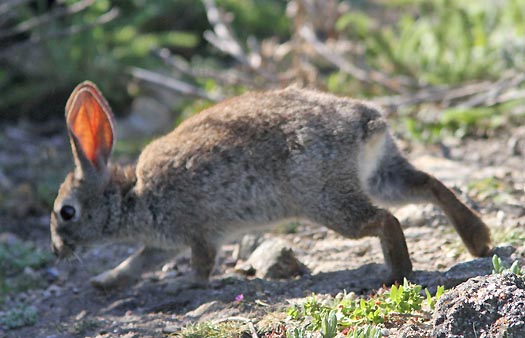 |
The three Monterey County (MTY) rabbits are:
Brush Rabbit Sylvilagus bachmani (above),
Desert Cottontail Sylvilagus audubonii (below), and
Black-tailed Jackrabbit Lepus californicus (right)
Although widespread throughout the
county, the first two are often confused, and the larger hare is fast
and difficult to photograph. We'll look at each separately. |
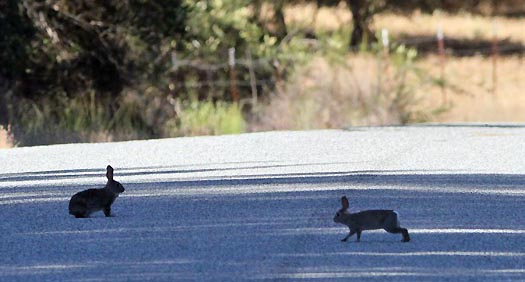 3 June 2012 Vineyard Canyon MTY
3 June 2012 Vineyard Canyon MTY
|
|
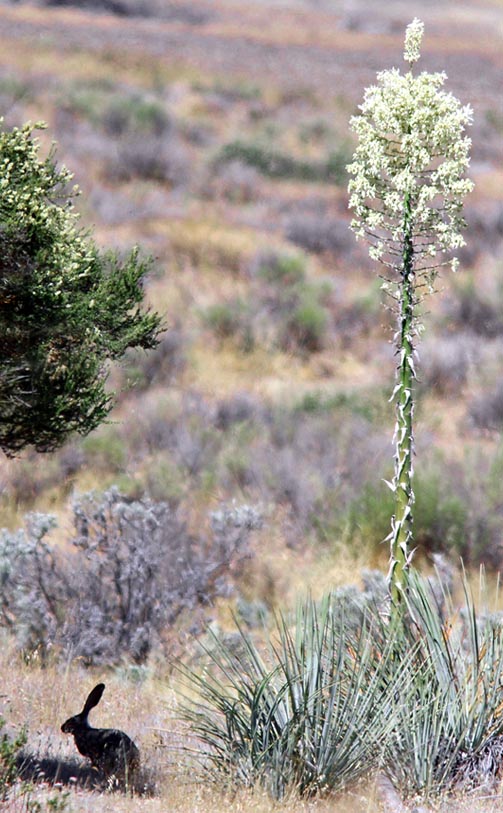
3 June 2012 Vineyard Canyon MTY
|
|
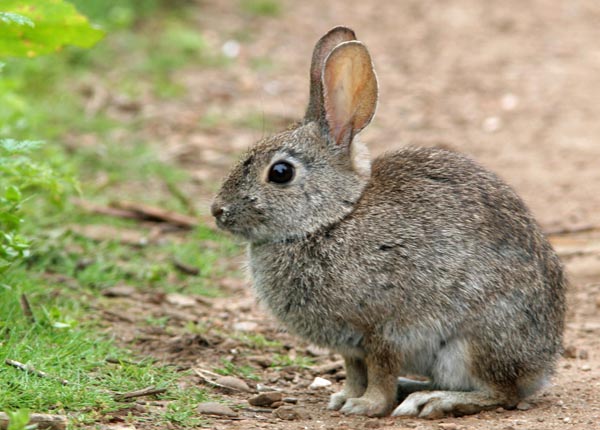 Brush Rabbit
is the small, short-eared, plain gray or gray-brown rabbit found in
thick scrub — including maritime chaparral, coastal sage scrub, inland
chaparral, montane chaparral, and humid riparian scrub — throughout
coastal and western Monterey County (right, photo 21 Mar 2008 Big Sur R. mouth). Brush Rabbit
is the small, short-eared, plain gray or gray-brown rabbit found in
thick scrub — including maritime chaparral, coastal sage scrub, inland
chaparral, montane chaparral, and humid riparian scrub — throughout
coastal and western Monterey County (right, photo 21 Mar 2008 Big Sur R. mouth).
For
identification purposes, note that the ears are comparatively short,
the tips of the ears are rather plain (only a dusky edge at the tip,
not a sharply demarcated black tip), and the entire rabbit looks gray,
with the back and sides essentially the same color. Dr. James Patton,
professor emeritus of mammalogy at U.C. Berkeley, describes the
differences as "short ears [equal to or shorter than length of face
from nose to base of ear], small tail, [but still white underneath],
little or no white hairs along anterior rim of pinna, fore and hind
limbs colored as dorsum and sides (not markedly counter-colored
ochraceous)."
|
 In contrast, Desert Cottontail (left, photo 13 Apr 2006 Borrego Valley, SD)
is a more colorful cottontail rabbit of open country, including
grasslands, oak and gray pine savanna, and agricultural land. As its
scientific name is Sylvilagus audubonii, some books call it "Audubon's Cottontail." In contrast, Desert Cottontail (left, photo 13 Apr 2006 Borrego Valley, SD)
is a more colorful cottontail rabbit of open country, including
grasslands, oak and gray pine savanna, and agricultural land. As its
scientific name is Sylvilagus audubonii, some books call it "Audubon's Cottontail."
For
identification purposes note that the overall color is browner and more
'grizzled;' there is a pale orange patch on the nape; the back is
darker than the sides; the ears are comparatively longer and have a
more distinct black tip; and the "cotton tail" is usually very apparent.
Dr. Patton notes that "both species have black edging on the ear tips, but this is much more extensive in audubonii
and contrasts sharply with the paler inner surface of the ears as well
as more extensive white hairs on the anterior edge — i.e., one easily
notices the black tips of audubonii, even from a distance, but for bachmani the smaller black tips can be 'hidden' against the dark gray-brown rest of the ear." Also, the whiskers or "vibrissae of audubonii are black, but again, because the face of audubonii is brightly colored, the black whiskers stand out in this species; the vibrissae of bachmani can be variable, but in most specimens are black — they just don't stand out against the dark face."
|
The
range of Brush Rabbit in California pretty much matches that of
chaparral habitat, which habitat is shown in the map below (from Fried
et al. 2004).

There
are 369,345 acres of chaparral habitat in MTY, if one includes
maritime, interior, and montane chaparral, and the vast majority is in
western MTY. [Maritime chaparral, 17,600 acres, makes up 4.7% of that.] |
The MTY range of Brush Rabbit pretty much matches the range of chaparral in the county. The approximate MTY range is shown below in blue; "x" marks a site it has been collected, "v" marks a known observation.
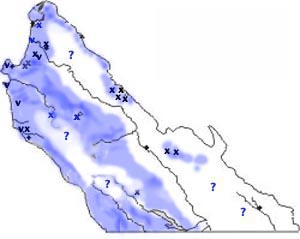
Localities
that host Brush Rabbits as residents include the coastal dunes from
Zmudowski SP south through the Big Sur coast, including populations at
Fort Ord NM (maritime chaparral), Salinas River NWR, Pebble Beach,
Carmel R. mouth, Pt. Lobos SR, and Big Sur R. mouth in Andrew Molera
SP. It has been collected near Hastings NHR; in chaparral near
Pinnacles NM; and in riparian scrub along the Salinas River near San
Lucas. It is possible that it occurs in patches of dense chaparral in
southeast MTY, but I'm now sure, so put question marks there. I am also
unsure whether it reaches the highest elevations in the Santa Lucia
Mts. (collected to 2400' at Big Pines), but is recorded to 7000' elev
elsewhere in California (Ingles 1965). [Specimens cited from MVZ, U.C. Berkeley on-line data base.] |
The MTY range of Desert Cottontail
is usually illustrated as the entire county, but I have not found
evidence it occurs west of the Santa Lucia Mts crest. The approximate
MTY range is shown below in pink; red "x" marks a site it has been collected, "v" marks a known observation.
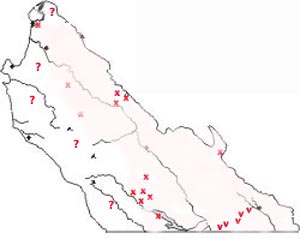
It
has been collected or observed widely eat of the Salinas River, and in
southern MTY throughout Ft. Hunter-Liggett/Lake San Antonio area. Here
it overlaps widely with Brush Rabbit, with cottontails in the
grasslands and savanna, and Brush Rabbits in the patches of chaparral
or thick riparian scrub. A mystery series of specimens near the coast
is discussed at the bottom of this page; otherwise, I am currently
unaware of any coastal records of this widespread rabbit. There are
many mislabeled photographs on the web, including several from "Elkhorn
Slough" where it may or may not occur. [Specimens cited from MVZ, U.C. Berkeley on-line data base.] |
|
|
| A comparison of these two rabbits from behind illustrate their differences again. To the left is Brush Rabbit,
very uniform grayish and unicolor, with short ears and inconspicuous
tail. Although it has a pale tawny wash to the nape in this view, it is
not a conspicuous character. To the right is Desert Cottontail, a more multi-colored rabbit with a prominent orangey nape, a very prominent white "cotton tail," and decidedly longer ears. |
|
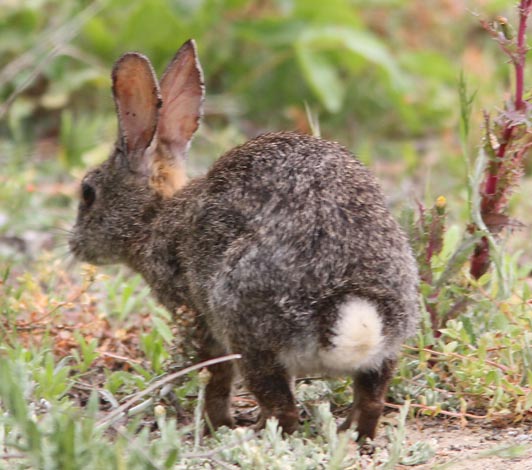 Brush Rabbit
does have a small "cotton-tail" but this is about as much as one ever
sees (left), while in Desert Cottontail the white cotton-tail is very
conspicuous, even at a long distance. Note again the very short ears
and unicolored gray pelage. Brush Rabbit
does have a small "cotton-tail" but this is about as much as one ever
sees (left), while in Desert Cottontail the white cotton-tail is very
conspicuous, even at a long distance. Note again the very short ears
and unicolored gray pelage.
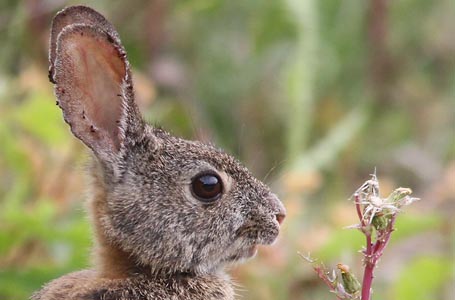
Note
again the short ears, very inconspicuous blackish tips to ears, and the
very inconspicuous whiskers (vibrissae), which are dull white to
grayish in this individual Brush Rabbit.
|
Our final rabbit in Monterey County is Black-tailed Jackrabbit Lepus californicus
(below). It is almost twice as big as a Brush Rabbit, and typically
weights 5 lbs. It has very long ears and strong long legs for fast
running. The tail is black above (dingy white below) with a black
stripe continuing up onto the rump. It is mostly nocturnal, feeding on
a variety of grasses and shrubs, and is more often seen sitting in the
shade during the day, if seen at all. It has pale yellow eyes as an
adult (our other MTY rabbits are dark-eyed).
Black-tailed
Jackrabbit is a very common and widespread species of open country,
including desert scrubland and Great Basin sage scrub, and is well
known throughout western arid landscapes. However, it seems much
scarcer in Monterey County, preferring the open grasslands of the
southeast. Yet is does range throughout MTY, and is regular along the
coast at places like the Salinas River NWR, and there are old specimens
for Carmel and Pebble Beach (1908, 1935 respectively). It was at Pt.
Lobos in the 1930s before that became a State Reserve and climax
Monterey pine forest. There are also specimens up to 3000' elev in the
Santa Lucia Mts. Thus, it can be recorded almost anywhere in MTY. |
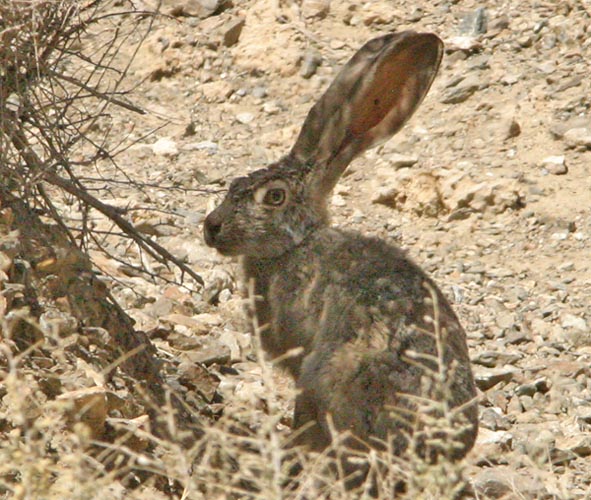 13 Aug 2007 Death Valley NP, INY
13 Aug 2007 Death Valley NP, INY |
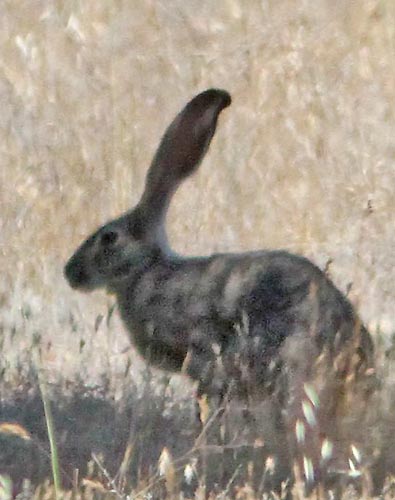 3 June 2012 Vineyard Cyn MTY
3 June 2012 Vineyard Cyn MTY |
|
| |
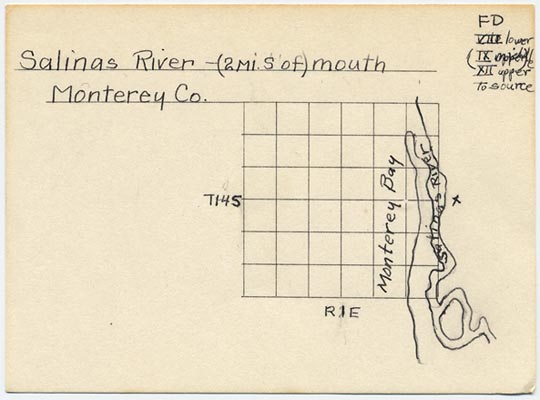 In researching this page, I did come upon a mystery regarding the small Sylvilagus rabbits. Using the on-line data base for the Museum of Vertebrate Zoology (MVZ), U.C. Berkeley, and searching for Sylvilagus
in Monterey County, I found only one location which listed both species
present and collected. Yes, there were specimens of both near Soledad
and near San Lucas, both in the Salinas Valley, but the lat-longs given
were difference and using google maps, one could see the habitat was
different. But the one location showing both species was listed as
"Sandhills, 2 mi S mouth Salinas River." There were 6 specimens of audubonii (Desert Cottontail) and 5 specimens of bachmani
(Brush Rabbit) credited to the same spot, all "live trapped" and
collected by J.R. Rowley (a well-known mammal collector of that era).
between 28-31 Aug 1907. In researching this page, I did come upon a mystery regarding the small Sylvilagus rabbits. Using the on-line data base for the Museum of Vertebrate Zoology (MVZ), U.C. Berkeley, and searching for Sylvilagus
in Monterey County, I found only one location which listed both species
present and collected. Yes, there were specimens of both near Soledad
and near San Lucas, both in the Salinas Valley, but the lat-longs given
were difference and using google maps, one could see the habitat was
different. But the one location showing both species was listed as
"Sandhills, 2 mi S mouth Salinas River." There were 6 specimens of audubonii (Desert Cottontail) and 5 specimens of bachmani
(Brush Rabbit) credited to the same spot, all "live trapped" and
collected by J.R. Rowley (a well-known mammal collector of that era).
between 28-31 Aug 1907.
Today, a location in
sandhills two miles south of the Salinas River mouth is almost in
Marina State Beach. The only habitat here is coastal sage scrub, and I
couldn't imagine both species there — it is classic Brush Rabbit
habitat. Dr. Carla Cicero, the ornithologist at MVZ, directed my
inquires to Dr. James Patton, retired professor of mammalogy. He
graciously examined the rabbit specimens; confirmed the i.d. of each;
and examined the specimen tags. The original tags all said "Salinas
Valley" but a secondary tag, placed there sometime later, gave the
location as "2 mi S of mouth of Salinas River." Why?
Rowley's
rabbits were accessioned into the MVZ collection in 1909 among 272
specimens of mammals. Digging deeper, Dr. Patton checked the back of
the accession card, and found the following written there: "The
'Salinas Valley' of Rowley's labels he tells me (Oct. 29-1918) refers
to a locality in the 'sand hills' within a mile of the ocean and two
miles south of the mouth of the Salinas River." This note is signed "J.
Grinnell" and is clearly written by him. So Joseph Grinnell himself,
the author of Grinnell (1918, 1933) actually talked to Rowley about
these specimens in 1918 — 11 years after they were collected — and was
given this specific location.
I was explaining
all this to my wife Rita Carratello, and she asked a question that
became the key to solving this mystery: "Where," she asked, "was the
Salinas River mouth in 1907?" Ah, yes. — where, indeed. I had forgotten
that part. As explained in detail by Gordon (1977), and mentioned in
figure 15, p. 21, of my own work (Roberson & Tenney 1993), the
Salinas River mouth's location changed dramatically during the winter
of 1909-1910. Before that the river bent northward when it hit the
dunes and emptied into the Pacific Ocean north of today's Moss Landing,
and just 3 miles from the Pajaro R. mouth. During storms in winter
1909-1910 it broke through the dunes near its current location, and
farmers blocked the old channel with flood gates to maintain the river
mouth at its current location, some 5.5 miles south of where it used to
be. [Later, as everyone knows, Moss Landing harbor was dredged and the
current entrance between rock jetties built in 1946].
This
meant that in August 1907, the mouth of the Salinas River was north of
Moss Landing, and "two miles" south would place the location somewhere
near today's Moss Landing Marine Lab — with sandhills to the west (with
Brush Rabbits in the coastal scrub) but the Moro Cojo floodplain to the
east (with Desert Cottontails in the open grassland). The 'mystery' of
the co-occurrence is thus solved. Further, MVZ maintains old hand-drawn
"locality cards" for older specimens (a practice given up long ago).
Reproduced above is the locality card for the location of these
rabbits: it uses an old 15' grid then in use, but the winding northward
nature of the Salinas River for 5+ miles northward can only illustrate
the "old" river mouth. The "x" on the card marks the location of our
mystery rabbits — right about at today's south end of Moss Landing town.
One
further point: all specimens of Desert Cottontail in MVZ from Monterey
County are attributed to the more southern California race vallicola, except the six from our 'mystery' site near the (then) Salinas R. mouth, which are labeled as nominate audubonii.
This, too, is explained by Joseph Grinnell who wrote in Grinnell (1933)
of the range of Sylvilagus audubonii audubonii: "Sacramento Valley and
San Francisco Bay region; recorded north to vicinity of Red Bluff,
Tehama Country, south into northern part of San Joaquin Valley as far
as Snelling, Merced Country, on east side, and Los Baños, Merced
County, on west side; south from Golden Gate to near mouth of Salinas
River in Monterey Country." This latter appears to be a direct
reference to Rowley's specimens. As to habitat, Grinnell (1933) says:
"Lives mostly in, and within forage radius of, stream-side and
river-bottom thickets; also on lowland plains clothed more or less
scatteringly with bushes." The Moro Cojo slough would have had lowland
plains with scattered bushes in 1907. |
| |
Acknowledgements:
Dr. James L. Patton, curator and professor emeritus, Museum of
Vertebrate Zoology, U.C. Berkeley, was extremely helpful in sorting out
the distribution and identification of Sylvilagus rabbits.
Literature cited:
Fried,
J.S., C.L. Bosinger, and D. Beardsley. 2004. Chaparral in Southern and
Central Coastal California in the Mid-1990s: Area, Ownership,
Condition, and Change. USFS Resource Bulletin PNW-RB-240.
Gordon, B.L. 1977. Monterey Bay Area: Natural History and Cultural Imprints. 2d ed. Boxwood Press, Pacific Grove.
Grinnell, J. 1913. A distributional list of the mammals of California. Proc. Cal. Acad. Sci., fourth series, vol. 111.
Grinnell, J. 1933. Review of the Recent Mammal Fauna of California. U.Cal.Press, Zoology 40: 71-234.
Ingles, L.G. 1965. Mammals of the Pacific States. Stanford Univ. Press, Stanford, CA.
Reid,
F. A. 2006. A Field Guide to Mammals of North America north of Mexico.
4th ed. Peterson Field Guide series. Houghton Mifflin, Boston.
Van
Dyke, E., and K. Holl. 2003. Mapping the Distribution of Maritime
Chaparral Species in the Monterey Bay Area. Prepared for U.S. Fish
& Wild. Serv., Ventura, CA.
|
| TOP |
|



 Brush Rabbit
is the small, short-eared, plain gray or gray-brown rabbit found in
thick scrub — including maritime chaparral, coastal sage scrub, inland
chaparral, montane chaparral, and humid riparian scrub — throughout
coastal and western Monterey County (right, photo 21 Mar 2008 Big Sur R. mouth).
Brush Rabbit
is the small, short-eared, plain gray or gray-brown rabbit found in
thick scrub — including maritime chaparral, coastal sage scrub, inland
chaparral, montane chaparral, and humid riparian scrub — throughout
coastal and western Monterey County (right, photo 21 Mar 2008 Big Sur R. mouth).  In contrast, Desert Cottontail (left, photo 13 Apr 2006 Borrego Valley, SD)
is a more colorful cottontail rabbit of open country, including
grasslands, oak and gray pine savanna, and agricultural land. As its
scientific name is Sylvilagus audubonii, some books call it "Audubon's Cottontail."
In contrast, Desert Cottontail (left, photo 13 Apr 2006 Borrego Valley, SD)
is a more colorful cottontail rabbit of open country, including
grasslands, oak and gray pine savanna, and agricultural land. As its
scientific name is Sylvilagus audubonii, some books call it "Audubon's Cottontail." 


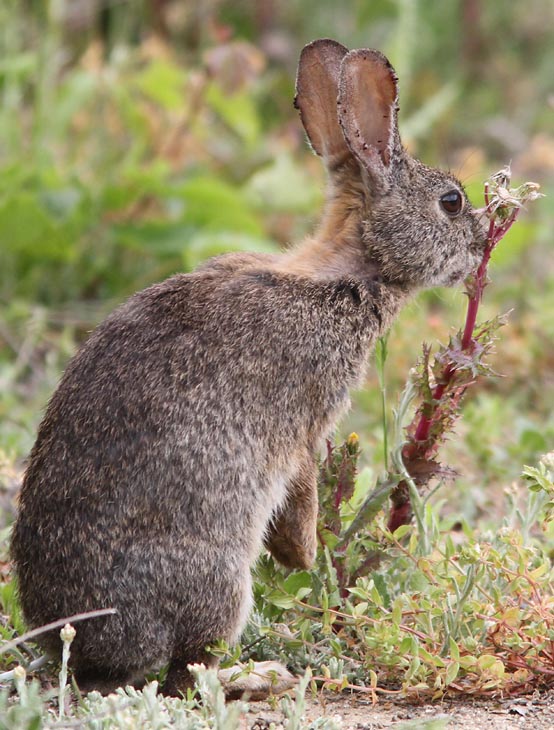
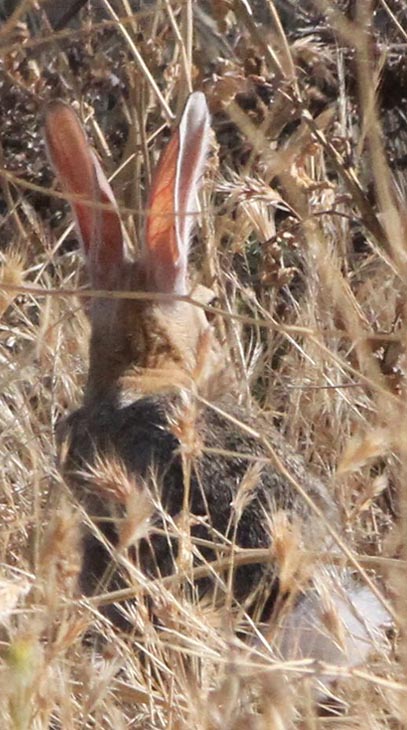
 Brush Rabbit
does have a small "cotton-tail" but this is about as much as one ever
sees (left), while in Desert Cottontail the white cotton-tail is very
conspicuous, even at a long distance. Note again the very short ears
and unicolored gray pelage.
Brush Rabbit
does have a small "cotton-tail" but this is about as much as one ever
sees (left), while in Desert Cottontail the white cotton-tail is very
conspicuous, even at a long distance. Note again the very short ears
and unicolored gray pelage. 


 In researching this page, I did come upon a mystery regarding the small Sylvilagus rabbits. Using the on-line data base for the
In researching this page, I did come upon a mystery regarding the small Sylvilagus rabbits. Using the on-line data base for the